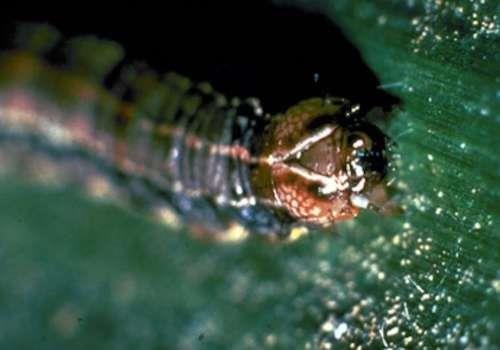Fall armyworms have a wide host range, but they primarily feed on grasses. They can also be problematic in alfalfa, soybean and vegetables. They get their name because the caterpillars can show up in large populations after hatching and move through fields quickly. Although the caterpillars are primarily defoliating the plants, older and larger caterpillars may destroy plants by feeding on the growing point.
Fall armyworm caterpillars may be an issue for emerging winter wheat this year. It is possible that we may see another generation of caterpillars this fall. This will be dependent on temperatures and the first hard frost. Fall armyworm caterpillars do not develop when temperatures drop below 55 degrees Fahrenheit. Scouting fields until temperatures are no longer favorable for the caterpillars will ensure that extensive feeding does not occur and early movement into wheat fields is detected.
Identification
Fall armyworm caterpillars vary greatly in color based on their growth stage and their diet. They are typically a tan or green color, but the shade of those colors can vary greatly. Later in the season and when populations are large, the caterpillars can be dark-brown to almost-black in color. The caterpillars have dark spots on their bodies. At the end of the abdomen, they have four black spots that form a square shape (Figure 1). Their head capsule can vary from light to dark brown but will have a distinct inverted white “Y” that is often bordered by a darker color towards the outside edges (Figure 2). During their last growth stage, the caterpillars are approximately 1.5 inches long.

Figure 1. Fall armyworm caterpillar with four black dots at end of abdomen (circled).

Figure 2. Fall armyworm caterpillar head capsule.
Scouting and Thresholds
The most effective way to determine if you have fall armyworms in your pastures or alfalfa is to use a sweep net. Scouting should occur in the early morning or evening, as the caterpillars are nocturnal feeders. If fall armyworm caterpillars are observed in the net, then determine how many caterpillars are in a square foot by examining the soil surface and the plant tissue. Repeat this process for four to five locations throughout the field. While scouting, also examine plants for signs of defoliation to determine if and where fall armyworm caterpillars are active. The defoliation injury caused by fall armyworm caterpillars will cause the leaves of the plants to have a ragged appearance.
Fields should be scouted until the first hard frost or daily high temperatures drop below 55 degrees Fahrenheit. Newly emerging winter wheat fields should be closely monitored this year to ensure that fall armyworm caterpillars don’t reduce stands.
Management
In some pastures, we have been informed that the fall armyworm caterpillars have already caused extensive feeding injury. These established fields should be rested until the grass is able to regrow. If fall armyworm caterpillars are still present at populations above the threshold of two to three caterpillars per square foot, an insecticide application should be considered to reduce further feeding. Temperatures that are above 55 degrees Fahrenheit and between 78 to 86 degrees Fahrenheit will lead to greater feeding injury by the caterpillars. Our current forecast looks favorable for fall armyworm caterpillar activity. The first hard frost will greatly reduce or remove the caterpillars, but until then management should occur when the threshold is reached.
There are a number of insecticide products that are labeled for fall armyworm management. Depending on the crop, carefully consider the pre-harvest intervals on the labels. The best results will be observed with high volume applications that occur either in the early morning or late afternoon or evening hours. If caterpillars are 0.75 of an inch or more in length, a higher rate should be used. Larger caterpillars are harder to manage.
Scout the entire field prior to management, as infestations may not be uniform. Spot spraying may be possible to effectively manage the populations.
Source : sdstate.edu